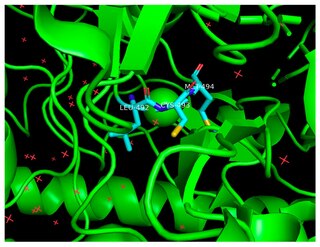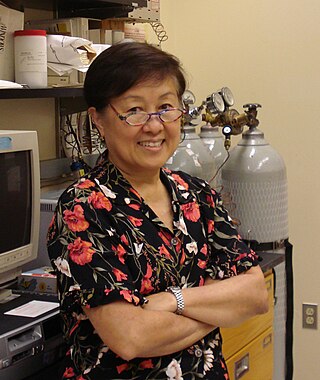Related Research Articles

Hydrogenation is a chemical reaction between molecular hydrogen (H2) and another compound or element, usually in the presence of a catalyst such as nickel, palladium or platinum. The process is commonly employed to reduce or saturate organic compounds. Hydrogenation typically constitutes the addition of pairs of hydrogen atoms to a molecule, often an alkene. Catalysts are required for the reaction to be usable; non-catalytic hydrogenation takes place only at very high temperatures. Hydrogenation reduces double and triple bonds in hydrocarbons.
Anaerobic respiration is respiration using electron acceptors other than molecular oxygen (O2). Although oxygen is not the final electron acceptor, the process still uses a respiratory electron transport chain.

Desulfobacterales are an order of sulfate-reducing bacteria within the phylum Thermodesulfobacteria. The order contains three families; Desulfobacteraceae, Desulfobulbaceae, and Nitrospinaceae. The bacterium in this order are strict anaerobic respirators, using sulfate or nitrate as the terminal electron acceptor instead of oxygen. Desulfobacterales can degrade ethanol, molecular hydrogen, organic acids, and small hydrocarbons. The bacterium of this order have a wide ecological range and play important environmental roles in symbiotic relationships and nutrient cycling.

Sulfate-reducing microorganisms (SRM) or sulfate-reducing prokaryotes (SRP) are a group composed of sulfate-reducing bacteria (SRB) and sulfate-reducing archaea (SRA), both of which can perform anaerobic respiration utilizing sulfate (SO2−
4) as terminal electron acceptor, reducing it to hydrogen sulfide (H2S). Therefore, these sulfidogenic microorganisms "breathe" sulfate rather than molecular oxygen (O2), which is the terminal electron acceptor reduced to water (H2O) in aerobic respiration.

Sulfur-reducing bacteria are microorganisms able to reduce elemental sulfur (S0) to hydrogen sulfide (H2S). These microbes use inorganic sulfur compounds as electron acceptors to sustain several activities such as respiration, conserving energy and growth, in absence of oxygen. The final product of these processes, sulfide, has a considerable influence on the chemistry of the environment and, in addition, is used as electron donor for a large variety of microbial metabolisms. Several types of bacteria and many non-methanogenic archaea can reduce sulfur. Microbial sulfur reduction was already shown in early studies, which highlighted the first proof of S0 reduction in a vibrioid bacterium from mud, with sulfur as electron acceptor and H
2 as electron donor. The first pure cultured species of sulfur-reducing bacteria, Desulfuromonas acetoxidans, was discovered in 1976 and described by Pfennig Norbert and Biebel Hanno as an anaerobic sulfur-reducing and acetate-oxidizing bacterium, not able to reduce sulfate. Only few taxa are true sulfur-reducing bacteria, using sulfur reduction as the only or main catabolic reaction. Normally, they couple this reaction with the oxidation of acetate, succinate or other organic compounds. In general, sulfate-reducing bacteria are able to use both sulfate and elemental sulfur as electron acceptors. Thanks to its abundancy and thermodynamic stability, sulfate is the most studied electron acceptor for anaerobic respiration that involves sulfur compounds. Elemental sulfur, however, is very abundant and important, especially in deep-sea hydrothermal vents, hot springs and other extreme environments, making its isolation more difficult. Some bacteria – such as Proteus, Campylobacter, Pseudomonas and Salmonella – have the ability to reduce sulfur, but can also use oxygen and other terminal electron acceptors.
Microbial metabolism is the means by which a microbe obtains the energy and nutrients it needs to live and reproduce. Microbes use many different types of metabolic strategies and species can often be differentiated from each other based on metabolic characteristics. The specific metabolic properties of a microbe are the major factors in determining that microbe's ecological niche, and often allow for that microbe to be useful in industrial processes or responsible for biogeochemical cycles.
In biology, syntrophy, syntrophism, or cross-feeding is the cooperative interaction between at least two microbial species to degrade a single substrate. This type of biological interaction typically involves the transfer of one or more metabolic intermediates between two or more metabolically diverse microbial species living in close proximity to each other. Thus, syntrophy can be considered an obligatory interdependency and a mutualistic metabolism between different microbial species, wherein the growth of one partner depends on the nutrients, growth factors, or substrates provided by the other(s).
Marinobacter hydrocarbonoclasticus is a species of bacteria found in sea water which are able to degrade hydrocarbons. The cells are rod-shaped and motile by means of a single polar flagellum.
Microbial biodegradation is the use of bioremediation and biotransformation methods to harness the naturally occurring ability of microbial xenobiotic metabolism to degrade, transform or accumulate environmental pollutants, including hydrocarbons, polychlorinated biphenyls (PCBs), polyaromatic hydrocarbons (PAHs), heterocyclic compounds, pharmaceutical substances, radionuclides and metals.

The enzyme benzylsuccinate synthase catalyzes the chemical reaction

Lily Young is a distinguished professor of environmental microbiology at Rutgers New Brunswick. She is also a member of the administrative council at Rutgers University. She is the provost of Rutgers New Brunswick. She is a member of the Biotechnology Center for Agriculture and the Environment and has her academic appointment in the Department of Environmental Sciences.
Alcanivorax borkumensis is an alkane-degrading marine bacterium which naturally propagates and becomes predominant in crude-oil-containing seawater when nitrogen and phosphorus nutrients are supplemented.
Desulfobacter hydrogenophilus is a strictly anaerobic sulfate-reducing bacterium. It was isolated and characterized in 1987 by Friedrich Widdel of the University of Konstanz (Germany). Like most sulfate-reducing bacteria (SRB), D. hydrogenophilus is capable of completely oxidizing organic compounds (specifically acetate, pyruvate and ethanol) to CO2, and therefore plays a key role in biomineralization in anaerobic marine environments. However, unlike many SRB, D. hydrogenophilus is a facultative lithoautotroph, and can grow using H2 as an electron donor and CO2 as a carbon source. D. hydrogenophilus is also unique because it is psychrophilic (and has been shown to grow at temperatures as low as 0 °C or 32 °F). It is also diazotrophic, or capable of fixing nitrogen.
Acidobacterium capsulatum is a bacterium. It is an acidophilic chemoorganotrophic bacterium containing menaquinone. It is gram-negative, facultative anaerobic, mesophilic, non-spore-forming, capsulated, saccharolytic and rod-shaped. It is also motile by peritrichous flagella. Its type strain is JCM 7670.

Bioremediation is the process of decontaminating polluted sites through the usage of either endogenous or external microorganism. In situ is a term utilized within a variety of fields meaning "on site" and refers to the location of an event. Within the context of bioremediation, in situ indicates that the location of the bioremediation has occurred at the site of contamination without the translocation of the polluted materials. Bioremediation is used to neutralize pollutants including Hydrocarbons, chlorinated compounds, nitrates, toxic metals and other pollutants through a variety of chemical mechanisms. Microorganism used in the process of bioremediation can either be implanted or cultivated within the site through the application of fertilizers and other nutrients. Common polluted sites targeted by bioremediation are groundwater/aquifers and polluted soils. Aquatic ecosystems affected by oil spills have also shown improvement through the application of bioremediation. The most notable cases being the Deepwater Horizon oil spill in 2010 and the Exxon Valdez oil spill in 1989. Two variations of bioremediation exist defined by the location where the process occurs. Ex situ bioremediation occurs at a location separate from the contaminated site and involves the translocation of the contaminated material. In situ occurs within the site of contamination In situ bioremediation can further be categorized by the metabolism occurring, aerobic and anaerobic, and by the level of human involvement.
Desulfatibacillum is a bacteria genus from the order Desulfobacterales.
Desulfatibacillum alkenivorans is an alkene-degrading, sulfate-reducing, Gram-negative, non-spore-forming and non-motile bacterium from the genus of Desulfatibacillum which has been isolated from oil polluted sediments in France.
Desulfococcus oleovorans is a bacterium from the genus Desulfococcus which has been isolated from mud from an oilfield near Hamburg in Germany.
A dearomatization reaction is an organic reaction in which the reactants are arenes and the products permanently lose their aromaticity. It is of some importance in synthetic organic chemistry for the organic synthesis of new building blocks and in total synthesis. Types of carbocyclic arene dearomization include hydrogenative, alkylative, photochemical, thermal, oxidative, transition metal-assisted and enzymatic.
Hydrocarbonoclastic bacteria are a heterogeneous group of prokaryotes which can degrade and utilize hydrocarbon compounds as source of carbon and energy. Despite being present in most of environments around the world, several of these specialized bacteria live in the sea and have been isolated from polluted seawater.
References
- 1 2 3 Callaghan, A. V.; Morris, B. E. L.; Pereira, I. a. C.; McInerney, M. J.; Austin, R. N.; Groves, J. T.; Kukor, J. J.; Suflita, J. M.; Young, L. Y. (2012-01-01). "The genome sequence of Desulfatibacillum alkenivorans AK-01: a blueprint for anaerobic alkane oxidation". Environmental Microbiology. 14 (1): 101–113. Bibcode:2012EnvMi..14..101C. doi:10.1111/j.1462-2920.2011.02516.x. ISSN 1462-2920. PMID 21651686.
- Aeckersberg, F., Bak, F. and Widdel, F.; 1991. "Anaerobic oxidation of saturated hydrocarbons to CO2 by a new type of sulfate-reducing bacterium." Arch. Microbiol. 156:5-14.
- Aeckersberg, F., Rainey, F. A. and Widdel, F.; 1998. "Growth, natural relationships, cellular fatty acids and metabolic adaptation of sulfate-reducing bacteria that utilize long-chain alkanes under anoxic conditions." Arch. Microbiol. 170:361-369.
- So, C. M., and Young, L. Y. 1999. "Isolation and characterization of a sulfate-reducing bacterium that anaerobically degrades alkanes." Appl Environ Microbiol 65:2969-76.